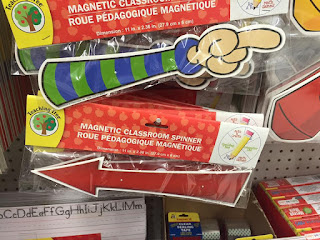One thing I love to do over summer break is visit all the thrift stores in town and sort through
their children’s book section. I love having my own classroom library, and one
of my biggest goals the past few years has been to add to it. I have a pretty
good idea of what the book could be used for as I buy it. (Here’s a post on what I look for in books.) I don’t have complete lessons for these books yet,
since I just got them, but I’ll post what they are and my ballpark of what they
could be used for, as well as amazon links if you want to check them out.
I’m kind of
shocked I don’t have this one yet. The lesson has definitely made the internet
rounds, and there’s a great Youtube video here with an extensive handout linked in the comments. One thing you could add is changing the
dynamics or tempo for each color. You could also use it with older students for
a lesson on theme and variation.
This is a
counting book with bugs. Each bug has a different locomotor movement. This book
could be used solely for movement, you could add instruments, or you could
split the class and do both. Bug finger puppets (or craft sticks with pictures
of bugs on them) could be fun, though you would need a lot of them.
This book explores
farm animals and how they sleep, so lullabies would be very easy to tie-in.
The book calls itself a “book of wonderful noises,” and it definitely delivers on that.
Each page is a new sound effect, which is just begging to have those sounds transferred
to instruments. I think I know what Kindergarten will be doing for Dr. Suess
week!
Spooky
enough for Halloween without actually saying anything about Halloween, this
book is an add-on adventure with loads of sound effects. Eventually all the noisy
parts following the old lady around make a scarecrow.
An oldie but
goodie first published in 1940, this book follows a sleepy cap salesman who has
a run-in with monkeys. He has 5 different types of hats, and the monkeys love
to copy what he does. There are several things you could do with this book.
Kids could echo with instruments or voice, be split into cap-groups for
improvisation, or learn form using the caps/cap manipulatives. It could easily
be adapted for a program as well.
Similar to the
Bad Kitty series, this book is a bit more accessible for music because George
does one bad thing at a time. There are several repeated phrases, so it would
be easy to create a song or two to go with this book.
This book
features several dinosaurs movin’ and groovin’ and an obvious refrain that is
begging to have a pentatonic melody. Movement could be a focus, as well as
singing and playing the refrain.
This is a
book of very short stories and poems with hand movements. It would be easy to
add a melody to them, or have students add a melody to them. There are several
about weather (rain and thunder is particular) that would work well with non-pitched
instruments.
Both of these
books are collections of short poems. I love collecting poem collection whenever
I can, because they can be great fun to transfer to drums. You can also have
students use them as a base for composition. I like to isolate pitch or rhythm
when students first compose so they don’t get overwhelmed, and a given poem is
a great way to have students focus on pitch.
I hope you
have fun finding the perfect book (or books!) for your kiddos!





























